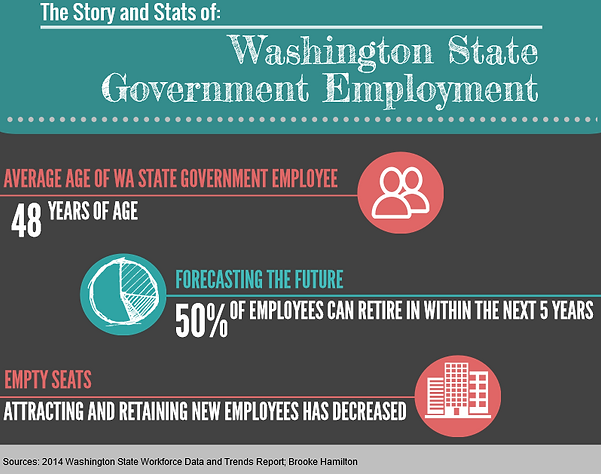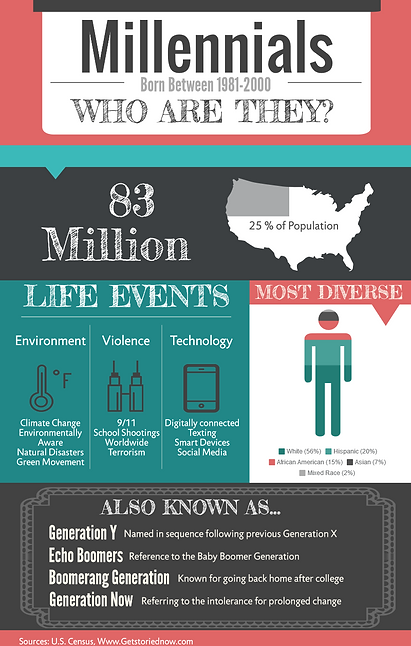
After touring the offices of four different Washington State government agencies, it was easy to see the lack of innovation. There are rows upon rows of gray identical cubicles. Compared to the Google offices... well, there is no comparison. Google is colorful, open, bright, and lively. It invokes a feeling of happiness and productivity.

What's the problem?
State Government Has Not Changed or Adapted Its Workplace Environment in over 50 Years
The drastic difference between private and public organizations has become more distinct in recent years as the private sector has had to adapt to a changing society and a new generation of workers. Government agencies, working to better the public good and not focusing on the bottom-line, haven't had to adapt to these same circumstances. In terms of attracting new talent and engaging younger workers, state agencies have been left in the dust.
The Millennial generation is soon to be the largest generation in the workforce (US Census, 2014; Washington State Workforce Data and Trends, 2014). However, as our work site visits and survey data show, the public workplace is not aligned with how Millennials most effectively engage in work. Many studies show that Millennials want to be connected, collaborative, and engaged in their work (DelCampo, Knippel, Haggerty, & Haney, 2012). According to our survey results, Millennials want work-life balance, as well as opportunities for advancement. Additionally, Millennials want to participate in work that has a larger impact, a sense of purpose, and is deep-rooted in meaning (Trendz E-Magazine, 2009; DelCampo, Knippel, Haggerty, & Haney, 2011).
While the private sector has been forced to reevaluate their workplace environment, public institutions have lagged behind and continue to operate using a mechanical approach to work (Meyers & Gee, 2014; Miller, Casey, & Konchar, 2014). This leads to repetitive work, isolated staff, and a low morale among employees. Millennials are choosing to work in private industries in order to bypass the mundane and dreaded cubicle farm (as we like to call it).
Washington State government is going to change soon because it has to. Over fifty percent of current state employees are eligible to retire in the next five years (Washington State Workforce Data and Trends, 2014). This could potentially cause half of all filled state positions to become empty. Who will they need to fill those seats? Millennials. The other issue at hand: new talent (i.e. Millennials) is not attracted to state work. Why do we think that is? Our hypothesis shows that it is because state agencies and their work environments have not changed. They are not reflective of modern day society, they are not innovative, and they do not inspire us to lead the lives we desire.
Solving the Problem
1. Understand the Generational Divide
Currently the workforce is made up of four generations: the Silent Generation, the Baby Boomers, Generation X, and the Millennials. By 2020 the labor force is anticipated to be made up of five generations, including Generation Z (Pew, 2015). Upon the arrival of Generation Z in to the workforce, history will be made. It will be the first time ever that five generations work together side-by-side. This is in part due to the fact that individuals are working and living longer. Because of this, generational diversity could continue to grow.
Each generation is unique, and has their own world view. Strauss and Howe (1992), theorize that generations are cyclical and repetitive. In addition to their notable theory, they identify the different generational cohort group traits which include: communication styles, core values, and personality traits (Strauss and Howe, 1992). The current comparison between the four generations in the workforce is between Baby Boomers and Millennials, who many researchers have coined as having very similar personality and attitude traits.
Although Millennials are said to be most like Baby Boomers, they are divided by how society has continued to quickly change in a globalized and tech obsessed world. Millennials and their position in the workforce has posed a new shift in leadership and communication styles. By the time Millennials are in their twenties they have already, or will have, spent 30,000 hours on the web (Bragen & Mors, 2011). Thus, they are heavily connected to the communication world that technology provides. In addition, it is appearing that as Millennials are coming of age and entering the workforce, there may be (for the first time in U.S. history) more gender equality in the workforce (Pew,2015).

2. Understand the "Millennials"
The Millennial generation is most commonly defined as individuals who were born between 1981 and 2000. According to the 2014 U.S. census data, there are about 83 million Millennials in the United States, making up over 25 percent of the total population. The Millennials are the most ethnically diverse generation to date (US Census 2014). Arguably, this has increased their acceptance of difference among individuals and has consequently made them more adept to collaborative work.
Millennials grew up during some very critical time periods, the most notable ones being the 9/11 attacks, and the “dot-com boom”. Just as other generations before them, the time period Millennials grew up in has highly impacted the characteristics of the larger generational cohort (Howe & Strauss, 1992). The Millennials were raised during times of high national and international violence, worldwide debate of climate change, also known as the “Green Movement”, and of course during the biggest time period of rapid technological advancement human kind has ever experienced.
We Millennials are unique in that we are the only generation to have experienced life with and without technology. This gives us an edge as we can relate to Baby Boomers, some who have no patience in dealing with the advancement of technology. Although frustrating, we understand the need for it and continue to keep up on the latest trends. Many people argue that Millennials are too attached to technology but as the need for global communication increases our skills will become higher in demand.
3. Innovate Washington State Government
Currently, the average age of the Washington State government employee is 48 years old (Washington State Workforce Data and Trends, 2014). According to the Washington State Workforce Data and Trends (2014), 70 percent of current state employees are over 40 years old, and roughly 50 percent will be able to retire within the next 5 years. With this situation we will begin to see the Baby Boomer generation begin to retire and will need the Millennial generation to fill the vacancies.
An interesting note is that Washington State is currently evaluating its telework policy and vamping up its workplace strategies. Thanks to Governor Inslee's Executive Order 14-02, (read more about it here) agencies have begun modernizing the workplace by implementing open workspaces, private “heads down” rooms, decreasing assigned cubicles (yay!), encouraging mobile work, and acknowledging workers’ desire for work-life balance.
As it stands, most government agencies assign cubicles that can create damaging cultural norms. Our research slightly covered this topic, and can affirm that there is an important connection to be made between space and workplace culture.

